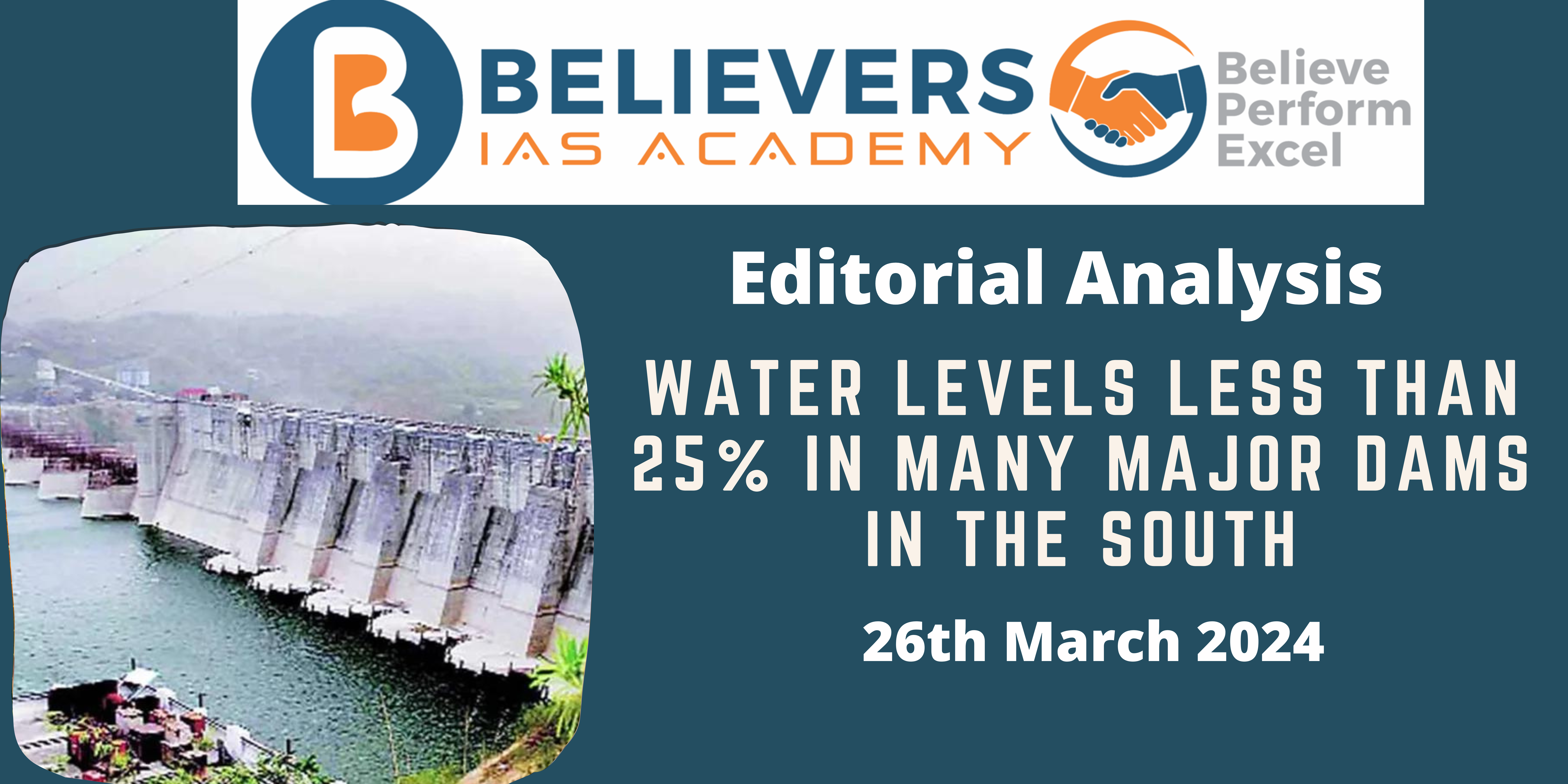Water levels less than 25% in many major dams in the south
Context:
Lack of rainfall and poor water management have together contributed to reduced water levels at major reservoirs of different states. The states such as Karnataka, Tamil Nadu, Andhra Pradesh, and Telangana shows critically low levels and has an alarming effect.
- About 7,082 villages across Karnataka are at risk of witnessing a drinking water crisis in the coming Summer months if the same condition prevails.
Relevance:
GS-03 (Conservation)
UPSC Mains Question:
What are the implications of declining water levels in cities. Propose strategies to mitigate the impending water crisis. (150 words)
Dimensions of the Article:
- The Issue
- Water Crisis in India
- Causes
- Solutions and way forward
- India’s Water Resource Management Initiatives
The Issue:
- Reservoirs such as Tungabhadra, Nagarjuna Sagar, Mettur, and Srisailam are filled to only fraction of their capacity- With some as low as 5%.
- This poses a significant threat as the demand for water escalates with the onset of the summer season.
- Particularly, Bengaluru faces the risk of acute water shortages if the situation persists alongside other major cities.
Water Crisis in India:
- India has about 18 percent of the world’s population but only 4 percent of the world’s water resources (NITI Aayog Report, 2017), making it among the most water stressed in the world.
- With 1,100 cubic meters (m3) per person, the available water falls significantly beneath the globally accepted threshold for water stress, set at 1,700 m3 per person, and is perilously near the threshold for water scarcity, which is 1,000 m3 per person.
- The crisis stems from a myriad of factors- rapid urbanization, industrialization, and unsustainable agricultural practices.
- This crisis manifests in both physical and economic forms.
- It poses significant threats to the nation’s development and stability.
- With 72% of water withdrawals allocated for agricultural use, the need for sustainable water management practices becomes increasingly pressing.
Causes:
- Several factors contribute to the declining water levels in southern reservoirs.
- Insufficient rainfall during the previous monsoon season.
- Mismanagement of water resources, including excessive extraction for agricultural and industrial purposes, has further depleted the available water supply.
- Inadequate infrastructure for rainwater harvesting and storage exacerbates the problem, leading to inefficient utilization of available water resources. The anticipated completion of Phase-5 of the Cauvery project which is designed to provide 110 litres of drinking water daily to 12 lakh people, is expected by May 2024.
- Karnataka received a 38% deficit in north-east Monsoon showers from October to December. The State received a 25% deficit in southwest monsoon rain from June to September.
- Excessive extraction has resulted in reduced groundwater levels which has even caused many borewells to dry up.
Solutions and Way Forward:
- Addressing the water crisis requires approaches that addresses both immediate concerns and long-term sustainability.
- Short-term measures:
- Implementing water rationing and conservation measures in urban areas.
- Promoting efficient irrigation techniques in agriculture.
- Enforcing strict regulations on water usage in industries.
- Enhancing the capacity of existing reservoirs through desilting and maintenance can help optimize water storage.
- Long-term solutions:
- It necessitate investments in sustainable water management practices, such as watershed management, groundwater recharge initiatives.
- Promoting the adoption of water-efficient technologies.
- Public awareness campaigns on water conservation and the importance of judicious water usage can also play a crucial role in fostering a culture of responsible water stewardship.
- Collaborative efforts among state governments, local authorities, and communities are essential to address the water crisis effectively.
- By prioritizing sustainable water management practices and adopting innovative solutions, southern states can mitigate the adverse impacts of dwindling water resources and ensure a reliable water supply for present and future generations.
India’s Water Resource Management Initiatives:
- National Disaster Management Agency (NDMA): Utilizes water-related data and technologies for disaster alerts and management by leveraging platforms like NavIC for timely dissemination of alerts.
- Pradhan Mantri Krishi Sinchayee Yojana (PMKSY): it was launched to enhance farm water access and promote efficient irrigation. It focuses on water use efficiency and conservation through micro-irrigation.
- Mission Amrit Sarovar: This aims to conserve and rejuvenate 75 water bodies in each district.
- Jal Shakti Abhiyan (JSA): Conducted in water-stressed districts for water conservation and management, with the “Catch the Rain” campaign promoting rainwater harvesting.
- Jal Jeevan Mission (JJM): Aims to provide potable tap water to every rural household by 2024. It focuses on water-scarce areas, including bulk water transfer and regional water supply schemes.
- Atal Bhujal Yojana (ABY): It is implemented in water-stressed areas of seven states, emphasizing community participation and demand-side interventions.
- National Commission on Integrated Water Resources Development (NCIWRD): Provides insights for planning and managing water resources through reports on projected water requirements.
- “Sahi Fasal” Campaign: Encourages water-efficient crop choices and sustainable cultivation practices in water-stressed areas for economic viability.




